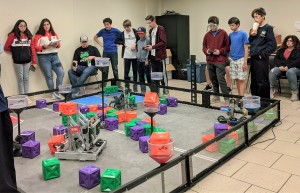By Cameron Hill
You’re sweating but not because you are running or jumping or sliding. Your robot has a problem. You are the leader of your team and this falls on you. You are feeling the stress but you have to stay calm and solve the problem. Finally, you fix your robot and you are back in the race.
This is the pressure the middle school VEX Robotics team faces every competition. A competition can last all day and it can be difficult to stay focused the whole time. The team has lofty goals too. Eighth-grader Will Chafey said the team’s goal is “to have fun and get to the state competition.” This goal is challenging but the team definitely has the talent to make it happen.
Meanwhile Coach Chris Mause’s goal is for “team members to come away with a gut-level understanding of the mechanics and software that makes up a robot.” And robotics definitely helps with teaching students about mechanics.
 Coaches Chris and Emily Mause described robotics as a “combination of physics, mechanics, code, and driving skill.” Robotics combines many different subjects in a fun and competitive way. Will Chafey described robotics as a “fun and interactive way to learn about different subjects in a more focused environment.” One of the main draws of robotics is how interactive it is while still learning things.
Coaches Chris and Emily Mause described robotics as a “combination of physics, mechanics, code, and driving skill.” Robotics combines many different subjects in a fun and competitive way. Will Chafey described robotics as a “fun and interactive way to learn about different subjects in a more focused environment.” One of the main draws of robotics is how interactive it is while still learning things.
The way a robotics competition works is you are assigned a table where your team can make code changes or mechanical adjustments in between rounds. A round consists of your team allied with another team versus two opposing teams which are allied together. The object of the game is to have your robot do the desired function to complete a specified challenge. The round lasts 2 minutes with the first 15 seconds being autonomous, meaning the robot does the challenge on its own. After the first 15 seconds your team’s driver takes over and uses a controller to move the robot.
This past Saturday Tempe Prep’s VEX Robotics team competed in a day long competition at Pan American Charter School in Maryvale. Two robots competed for Tempe Prep, group A and group B. Sixteen high school teams and nine middle school teams competed. Each team competed in six qualifying matches and group B finished at rank 14 while group A finished at rank 21. The two groups went on to face each other in the first elimination round and group B emerged victorious. Group B then faced the rank 1 team in the quarterfinals and suffered a heartbreaking defeat.
Will Chafey is the lead programmer for one of Tempe Prep’s two robots. As lead programmer Will has “to make sure others are staying on task and helping.” He also must lead the design process for the robot which can take three months of arduous work. Making sure everyone is on task is difficult, so doing this as an eighth-grader is very impressive.
Each of the robots must be able to “stack one block on top of another and go fast if needed,” and It must be able to “also push other bots out of the way if needed during a match.” Will said the biggest challenge for making a robot is “making sure that things it does are repeatable and ‘safe,’” but he said that they “solve this with trial and error since not everything will be as planned.”
Both coaches agreed that most people are surprised at “how exciting the matches are,” and “There’s a lot going on in the arena during those two-minute matches.” The robotics team always welcomes fans and would love to see the Knights come out and support the team.
